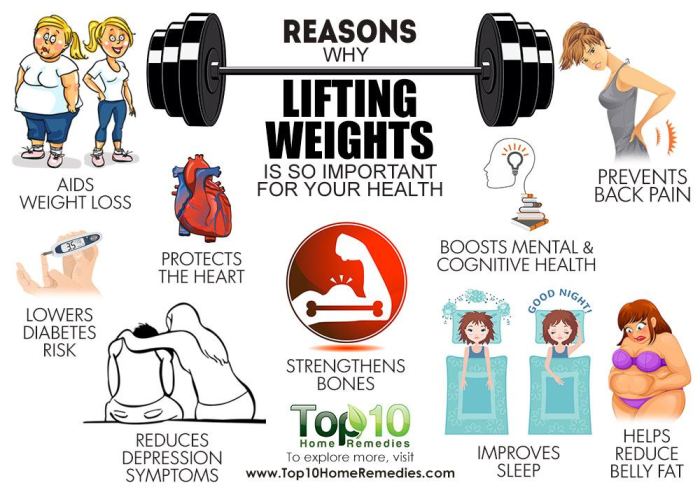Weight training for health is not just about building muscles; it’s about investing in your overall well-being. From improving bone density to boosting mood, the benefits of weight training extend far beyond the gym.
This comprehensive guide will delve into the world of weight training, empowering you with the knowledge and tools to create a personalized program that aligns with your fitness goals. Discover the different types of exercises, principles, and safety precautions to train effectively and safely.
Introduction

Weight training, often referred to as strength training or resistance training, is a crucial component of maintaining overall health and well-being. It involves exercising against resistance to build muscle strength, endurance, and power. Engaging in regular weight training offers numerous benefits that extend beyond aesthetics and physical appearance, positively impacting various aspects of health.
Weight training is particularly beneficial for maintaining bone density, preserving muscle mass, and enhancing cardiovascular function. These factors are essential for maintaining mobility, independence, and reducing the risk of chronic diseases as we age.
Bone Density
As we age, our bones naturally lose density, making them more susceptible to fractures and osteoporosis. Weight training helps counteract this process by increasing the stress on bones, stimulating them to become stronger and denser. This is particularly important for postmenopausal women and older adults who are at a higher risk of developing osteoporosis.
Muscle Mass
Weight training is essential for preserving and building muscle mass, which plays a vital role in mobility, balance, and metabolism. As we age, we naturally lose muscle mass, a condition known as sarcopenia. Weight training helps counteract this process by stimulating muscle growth and preventing muscle loss.
Maintaining muscle mass is crucial for performing everyday activities, reducing the risk of falls, and improving overall quality of life.
Cardiovascular Function
Contrary to popular belief, weight training is not just about building muscles. It also has significant benefits for cardiovascular health. Weight training helps lower blood pressure, improves cholesterol levels, and strengthens the heart. By increasing muscle mass, weight training also increases the body’s ability to use oxygen efficiently, improving overall cardiovascular function.
Types of Weight Training Exercises

Weight training exercises can be classified into three main categories: bodyweight exercises, free weight exercises, and machine exercises. Each type of exercise targets different muscle groups and offers unique benefits.
Bodyweight Exercises
Bodyweight exercises use your own body as resistance. They are convenient, require no equipment, and can be performed anywhere.
- Push-ups: Chest, triceps, shoulders
- Squats: Quadriceps, hamstrings, glutes
- Lunges: Quadriceps, hamstrings, glutes
- Plank: Core, back
- Pull-ups: Back, biceps
Free Weight Exercises, Weight training for health
Free weight exercises involve using dumbbells, barbells, or kettlebells. They provide greater flexibility and allow for a wider range of motion.
- Bench press: Chest, triceps, shoulders
- Squat: Quadriceps, hamstrings, glutes
- Deadlift: Back, hamstrings, glutes
- Overhead press: Shoulders, triceps
- Bicep curls: Biceps
Machine Exercises
Machine exercises are performed using weightlifting machines. They provide a guided movement and are suitable for beginners or those with specific injuries.
- Leg press: Quadriceps, hamstrings, glutes
- Chest press machine: Chest, triceps, shoulders
- Lat pulldown: Back, biceps
- Leg extension: Quadriceps
- Hamstring curl: Hamstrings
Weight Training Principles
Weight training, when done correctly, can provide numerous benefits for health and well-being. Understanding and adhering to the fundamental principles of weight training is crucial for maximizing these benefits and ensuring a safe and effective workout routine.
These principles guide the design and implementation of weight training programs, ensuring they are tailored to individual needs, goals, and fitness levels. By incorporating these principles into your workouts, you can optimize your progress, reduce the risk of injury, and achieve your desired results.
Progressive Overload
Progressive overload is the gradual and controlled increase in the weight lifted, sets performed, or repetitions completed over time. This principle is essential for continued muscle growth and strength development. As your body adapts to the current level of resistance, it becomes necessary to challenge it further to promote ongoing progress.
Progressive overload can be achieved through various methods, such as increasing the weight used, adding more sets or repetitions to your workouts, or reducing rest periods between sets. It’s important to progress gradually to avoid injury and allow your body to adapt and recover adequately.
Specificity
The principle of specificity states that the adaptations you gain from weight training are specific to the exercises you perform. In other words, the muscles and movements you train will experience the most significant benefits.
For example, if your goal is to improve your bench press, you should incorporate exercises that specifically target the muscles involved in this movement, such as the bench press itself, incline dumbbell press, and tricep extensions. By focusing on exercises that mimic the desired movement, you can effectively enhance your performance in that particular activity.
Recovery
Recovery is an essential but often overlooked aspect of weight training. Adequate rest and recovery allow your muscles to repair and rebuild, preparing them for your next workout. Without sufficient recovery, your performance may suffer, and your risk of injury increases.
Recovery involves getting enough sleep, consuming a nutritious diet, and taking rest days between workouts. Active recovery methods, such as light cardio or stretching, can also promote recovery by improving blood flow and reducing muscle soreness.
– Guide the user through the process of designing a personalized weight training program that aligns with their fitness goals.: Weight Training For Health

Crafting a personalized weight training program is a journey that starts with understanding your fitness goals. Whether you’re seeking muscle growth, strength enhancement, or overall fitness, tailoring your program to your specific aspirations is crucial.
Exercise Selection
Choosing the right exercises is paramount. Target muscle groups relevant to your goals. For instance, squats and deadlifts engage multiple lower body muscles, while bench press and overhead press focus on the upper body.
Set and Repetition Schemes
Sets and repetitions determine the intensity and volume of your workout. For muscle growth, aim for 8-12 repetitions per set, with 3-4 sets per exercise. For strength, opt for 6-8 repetitions with heavier weights.
| Fitness Level | Goal | Sets | Repetitions |
|---|---|---|---|
| Beginner | General Fitness | 2-3 | 10-15 |
| Intermediate | Muscle Growth | 3-4 | 8-12 |
| Advanced | Strength | 4-6 | 6-8 |
Rest Periods
Rest periods allow your muscles to recover. For strength training, rest for 2-3 minutes between sets. For muscle growth, rest for 1-2 minutes. Adjust rest times based on the intensity and volume of your workout.
Progressive Overload
To continue making progress, gradually increase weight or resistance over time. This forces your muscles to adapt and grow stronger. Add weight or increase the number of sets or repetitions every 2-4 weeks.
Sample Weight Training Program
This sample program is a starting point. Adjust it based on your goals and fitness level.
- Monday: Chest, Triceps
- Tuesday: Rest
- Wednesday: Back, Biceps
- Thursday: Rest
- Friday: Legs, Glutes
- Saturday: Rest
- Sunday: Rest
Reflecting on Fitness Goals
Regularly assess your progress and adjust your program as needed. Reflect on whether your workouts are challenging you and helping you reach your goals. Make modifications to keep your training aligned with your aspirations.
Nutrition for Weight Training

To maximize the benefits of weight training, a well-rounded nutrition plan is crucial. It provides the building blocks for muscle growth, recovery, and overall performance. Let’s dive into the importance of nutrition and explore essential guidelines for fueling your weight training journey.
The right nutrition supports your body’s ability to repair and rebuild muscle tissue, leading to increased strength and size. It also optimizes recovery, reduces muscle soreness, and enhances energy levels during workouts.
Macronutrient Intake
Your macronutrient intake should align with your weight training goals. Aim for a balance of:
- Protein:1.6-2.2 grams per kilogram of body weight daily for muscle growth and repair.
- Carbohydrates:4-6 grams per kilogram of body weight daily for energy during workouts.
- Fat:1-1.2 grams per kilogram of body weight daily for hormone production and cell function.
Hydration
Staying adequately hydrated is essential. Aim to drink 8-10 glasses of water daily, especially before, during, and after workouts.
Meal Timing
To maximize nutrient absorption and support muscle recovery, consider the timing of your meals:
- Pre-workout:Consume a small meal 1-2 hours before your workout to provide energy.
- Post-workout:Within 30 minutes of finishing your workout, consume a protein-rich meal to promote muscle repair.
Warm-Up and Cool-Down
Before and after weight training sessions, warming up and cooling down are crucial for injury prevention, performance enhancement, and recovery.
Warming up prepares your body for the strenuous activity of weightlifting by gradually increasing heart rate, blood flow, and muscle temperature. This helps reduce muscle stiffness, improve flexibility, and enhance range of motion. Cooling down, on the other hand, aids in the removal of waste products like lactic acid, reduces muscle soreness, and promotes relaxation.
Warm-Up Exercises
- Dynamic Stretching:Controlled movements that mimic the exercises you’ll be performing, such as arm circles, leg swings, and lunges.
- Light Cardio:5-10 minutes of brisk walking, jogging, or cycling to raise your heart rate and increase blood flow.
- Foam Rolling:Using a foam roller to release muscle tension and improve flexibility.
Cool-Down Exercises
- Static Stretching:Holding a stretch for 15-30 seconds to improve flexibility and range of motion.
- Light Cardio:5-10 minutes of walking or cycling to gradually decrease your heart rate.
- Self-Massage:Using your hands or a massage ball to release muscle tension and promote relaxation.
Benefits of Warming Up and Cooling Down
- Reduced risk of injuries
- Improved performance
- Enhanced recovery
- Reduced muscle soreness
- Improved flexibility and range of motion
- Increased blood flow and oxygen delivery
Stretching
Stretching is an important component of both warming up and cooling down. It improves flexibility, reduces muscle tightness, and helps prevent injuries. Dynamic stretching should be performed before weight training, while static stretching is best suited for cooling down.
Safety Precautions
Weight training, like any other form of exercise, requires careful attention to safety. Proper form, adequate supervision, and listening to your body are crucial for a safe and effective workout.
Common Weight Training Injuries and Prevention
| Injury | Prevention |
|---|---|
| Strains and Sprains | Warm up properly, use proper technique, avoid overexertion. |
| Muscle Tears | Use a spotter, avoid lifting too much weight, listen to your body. |
| Joint Pain | Use proper form, avoid repetitive movements, stretch regularly. |
| Lower Back Pain | Strengthen core muscles, use proper lifting technique, avoid excessive weight. |
Tips for Safe Weight Training
- Warm up thoroughly before each workout.
- Use proper lifting technique to avoid injury.
- Avoid lifting excessive weight.
- Stay hydrated by drinking plenty of water before, during, and after workouts.
- Cool down after each workout to help your body recover.
- Listen to your body and rest when you need to.
- If you experience any pain, stop exercising and consult a healthcare professional.
Weight Training for Different Populations
Weight training offers numerous benefits for individuals of all ages and fitness levels. However, tailored modifications and adaptations are necessary to ensure accessibility and effectiveness for specific populations.
This section provides comprehensive guidance on weight training for beginners, seniors, and individuals with health conditions, addressing common myths and misconceptions.
Beginners
For beginners, it’s crucial to establish a solid foundation. Start with a light weight and gradually increase the resistance as you progress. Focus on proper form to avoid injuries and maximize results.
- Exercise Selection:Choose compound exercises that work multiple muscle groups simultaneously, such as squats, lunges, and push-ups.
- Intensity:Begin with a weight that allows for 12-15 repetitions with good form.
- Sets and Reps:Aim for 2-3 sets of 10-15 repetitions for each exercise.
- Progression:Gradually increase the weight or resistance as you get stronger.
Seniors
Weight training can help seniors maintain strength, mobility, and independence. Modifications may include using lighter weights, shorter sets, and more rest periods.
- Exercise Selection:Focus on exercises that improve balance and functional movements, such as chair squats, bicep curls, and seated rows.
- Intensity:Choose a weight that allows for 8-12 repetitions with good form.
- Sets and Reps:Aim for 2-3 sets of 8-12 repetitions for each exercise.
- Progression:Gradually increase the weight or resistance as tolerated.
Individuals with Health Conditions
Weight training can be beneficial for individuals with certain health conditions, such as osteoporosis, arthritis, and diabetes. Consult a healthcare professional before starting an exercise program.
- Osteoporosis:Weight-bearing exercises, such as squats and lunges, can help increase bone density.
- Arthritis:Low-impact exercises, such as swimming or cycling, can help reduce joint pain and improve flexibility.
- Diabetes:Resistance training can help improve insulin sensitivity and blood sugar control.
Ultimate Conclusion
Weight training is a powerful tool that can transform your health and longevity. By following the principles Artikeld in this guide, you can harness its benefits to build a stronger, healthier, and more fulfilling life.
Remember, consistency is key. Make weight training a regular part of your routine, and you will reap the rewards for years to come.
User Queries
Is weight training safe for beginners?
Yes, weight training is safe for beginners when done correctly. Start with a light weight and gradually increase the weight as you get stronger.
How often should I do weight training?
Aim for 2-3 weight training sessions per week, with at least 24 hours of rest between sessions.
What is progressive overload?
Progressive overload is gradually increasing the weight, sets, or reps over time to challenge your muscles and promote growth.
How do I prevent injuries during weight training?
Always warm up before lifting weights, use proper form, and listen to your body. If you experience any pain, stop the exercise and consult a doctor.
Can weight training help me lose weight?
Yes, weight training can help you lose weight by building muscle, which increases your metabolism and burns fat.
Leave a Reply